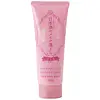What's inside
What's inside
 Key Ingredients
Key Ingredients

No key ingredients
 Benefits
Benefits

 Concerns
Concerns

 Ingredients Side-by-side
Ingredients Side-by-side

Water
Skin ConditioningDipropylene Glycol
HumectantPEG-20 Glyceryl Triisostearate
EmollientPEG-20 Glyceryl Isostearate
Rice Ferment Lees
HumectantGlutamic Acid
HumectantArginine
MaskingLeucine
Skin ConditioningPlacental Extract
Arbutin
AntioxidantDipotassium Glycyrrhizate
HumectantSqualane
EmollientPseudozyma Epicola/Olive Fruit Oil Ferment Filtrate
HumectantBis-Ethoxydiglycol Cyclohexane 1,4-Dicarboxylate
EmollientCaprylic/Capric Triglyceride
MaskingPentylene Glycol
Skin ConditioningCarbomer
Emulsion StabilisingSodium Hydroxide
BufferingPhenoxyethanol
PreservativeMethylparaben
PreservativeParfum
MaskingWater, Dipropylene Glycol, PEG-20 Glyceryl Triisostearate, PEG-20 Glyceryl Isostearate, Rice Ferment Lees, Glutamic Acid, Arginine, Leucine, Placental Extract, Arbutin, Dipotassium Glycyrrhizate, Squalane, Pseudozyma Epicola/Olive Fruit Oil Ferment Filtrate, Bis-Ethoxydiglycol Cyclohexane 1,4-Dicarboxylate, Caprylic/Capric Triglyceride, Pentylene Glycol, Carbomer, Sodium Hydroxide, Phenoxyethanol, Methylparaben, Parfum
Water
Skin ConditioningGlycerin
HumectantStearic Acid
CleansingMyristic Acid
CleansingLauric Acid
CleansingPotassium Hydroxide
BufferingGlyceryl Stearate Se
EmulsifyingPEG-6
HumectantPEG-32
HumectantSodium Methyl Cocoyl Taurate
CleansingSodium Phosphate
BufferingParfum
MaskingPolyquaternium-7
Tetrasodium EDTA
Dipropylene Glycol
HumectantButylene Glycol
HumectantSodium Benzoate
MaskingAcetyl Glucosamine
Skin ConditioningPrunus Persica Leaf Extract
EmollientWater, Glycerin, Stearic Acid, Myristic Acid, Lauric Acid, Potassium Hydroxide, Glyceryl Stearate Se, PEG-6, PEG-32, Sodium Methyl Cocoyl Taurate, Sodium Phosphate, Parfum, Polyquaternium-7, Tetrasodium EDTA, Dipropylene Glycol, Butylene Glycol, Sodium Benzoate, Acetyl Glucosamine, Prunus Persica Leaf Extract
 Reviews
Reviews

Alternatives
Ingredients Explained
These ingredients are found in both products.
Ingredients higher up in an ingredient list are typically present in a larger amount.
Dipropylene Glycol is a synthetically created humectant, stabilizer, and solvent.
This ingredient helps:
Dipropylene glycol is technically an alcohol, but it belongs to the glycol family (often considered part of the ‘good’ alcohols). This means it is hydrating and gentle on skin unlike drying solvent alcohols like denatured alcohol.
As a masking agent, Dipropylene Glycol can be used to cover the smell of other ingredients. However, it does not have a scent.
Studies show Dipropylene Glycol is considered safe to use in skincare.
Learn more about Dipropylene GlycolParfum is a catch-all term for an ingredient or more that is used to give a scent to products.
Also called "fragrance", this ingredient can be a blend of hundreds of chemicals or plant oils. This means every product with "fragrance" or "parfum" in the ingredients list is a different mixture.
For instance, Habanolide is a proprietary trade name for a specific aroma chemical. When used as a fragrance ingredient in cosmetics, most aroma chemicals fall under the broad labeling category of “FRAGRANCE” or “PARFUM” according to EU and US regulations.
The term 'parfum' or 'fragrance' is not regulated in many countries. In many cases, it is up to the brand to define this term.
For instance, many brands choose to label themselves as "fragrance-free" because they are not using synthetic fragrances. However, their products may still contain ingredients such as essential oils that are considered a fragrance by INCI standards.
One example is Calendula flower extract. Calendula is an essential oil that still imparts a scent or 'fragrance'.
Depending on the blend, the ingredients in the mixture can cause allergies and sensitivities on the skin. Some ingredients that are known EU allergens include linalool and citronellol.
Parfum can also be used to mask or cover an unpleasant scent.
The bottom line is: not all fragrances/parfum/ingredients are created equally. If you are worried about fragrances, we recommend taking a closer look at an ingredient. And of course, we always recommend speaking with a professional.
Learn more about ParfumWater. It's the most common cosmetic ingredient of all. You'll usually see it at the top of ingredient lists, meaning that it makes up the largest part of the product.
So why is it so popular? Water most often acts as a solvent - this means that it helps dissolve other ingredients into the formulation.
You'll also recognize water as that liquid we all need to stay alive. If you see this, drink a glass of water. Stay hydrated!
Learn more about Water